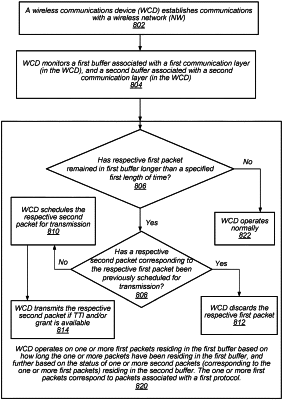|
1. A non-transitory memory device storing programming instructions executable by a processing element to cause a wireless communication device to: establish communications with a wireless network (NW); monitor a first buffer comprised in the wireless communication device and associated with a first communication layer; monitor a second buffer comprised in the wireless communication device and associated with a second communication layer; and operate, on one or more packets from among one or more first packets and/or one or more second packets, based on how long the one or more first packets have been residing in the first buffer, and further based on status information corresponding to the one or more second packets, wherein the one or more second packets correspond to the one or more first packets and reside in the second buffer; wherein the programming instructions are executable by the processing element to cause the wireless communication device to perform one of the following to operate on the one or more packets: discard one or more of the one or more first packets; or schedule one or more of the one or more second packets for transmission.
|
